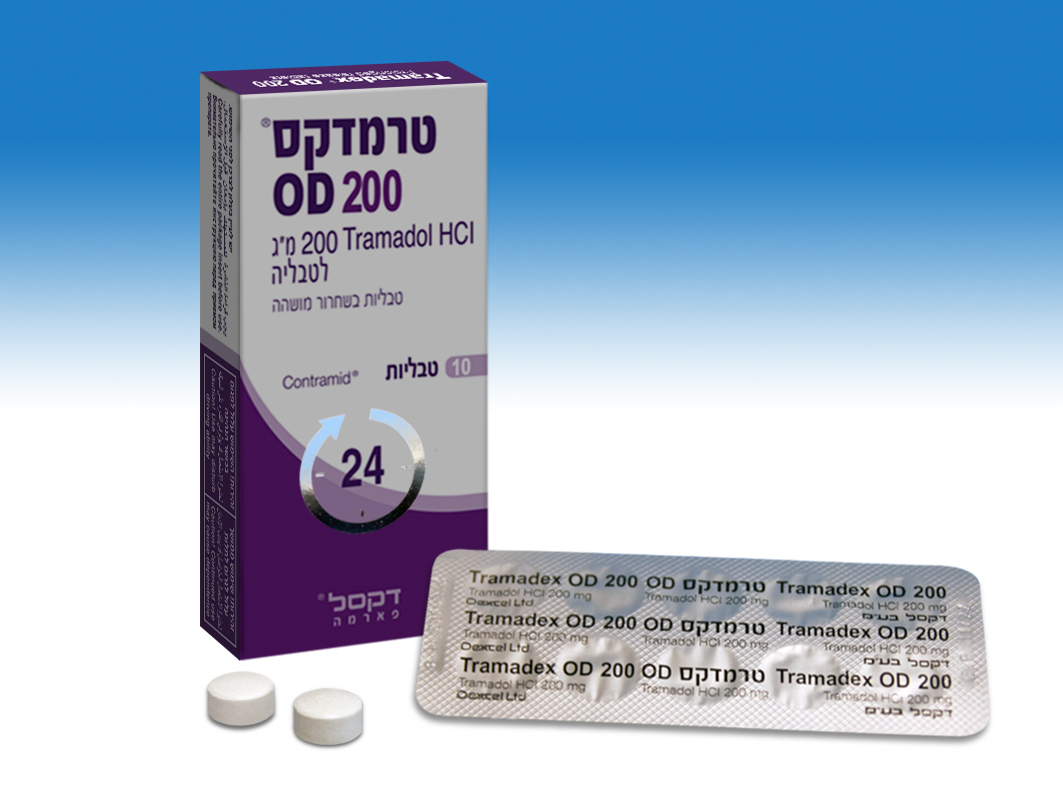Quest for the right Drug

טרמדקס OD 200 TRAMADEX OD 200 (TRAMADOL HYDROCHLORIDE)
תרופה במרשם
תרופה בסל
נרקוטיקה
ציטוטוקסיקה
צורת מתן:
פומי : PER OS
צורת מינון:
טבליות בשחרור ממושך : TABLETS PROLONGED RELEASE
עלון לרופא
מינוניםPosology התוויות
Indications תופעות לוואי
Adverse reactions התוויות נגד
Contraindications אינטראקציות
Interactions מינון יתר
Overdose הריון/הנקה
Pregnancy & Lactation אוכלוסיות מיוחדות
Special populations תכונות פרמקולוגיות
Pharmacological properties מידע רוקחי
Pharmaceutical particulars אזהרת שימוש
Special Warning עלון לרופא
Physicians Leaflet
Special Warning : אזהרת שימוש
4.4 Special warnings and precautions for use Consumption of alcohol is not recommended during treatment with tramadol. Concomitant treatment with carbamazepine is not recommended (see section 4.5). Warnings: Tolerance and psychic and physical dependence may develop, especially after long-term use. At therapeutic doses, withdrawal symptoms have been reported with a frequency of 1 in 8,000 while reports of dependence and abuse have been less frequent. Because of the potential for dependence or withdrawal to occur, the clinical need for continued analgesia should be reviewed regularly. In patients with a tendency to drug abuse or dependence, tramadol should only be used for short periods under strict medical surveillance. When a patient no longer requires therapy with tramadol, it may be advisable to taper the dose gradually to prevent symptoms of withdrawal. Tramadol is not suitable as a substitute in opioid dependent patients. Although it is an opioid agonist, tramadol cannot suppress morphine withdrawal symptoms. Respiratory depression or patient taking CNS depressants: Caution is recommended with administration of tramadol in patients at risk for respiratory depression or receiving medicinal products likely to produce respiratory depression. Sleep-related breathing disorders Opioids can cause sleep-related breathing disorders including central sleep apnoea (CSA) and sleep-related hypoxemia. Opioid use increases the risk of CSA in a dose-dependent fashion. In patients who present with CSA, consider decreasing the total opioid dosage. Adrenal insufficiency Opioid analgesics may occasionally cause reversible adrenal insufficiency requiring monitoring and glucocorticoid replacement therapy. Symptoms of acute or chronic adrenal insufficiency may include e.g. severe abdominal pain, nausea and vomiting, low blood pressure, extreme fatigue, decreased appetite, and weight loss. Serotonin syndrome: Serotonin syndrome, a potentially life-threatening condition, has been reported in patients receiving tramadol in combination with other serotonergic agents or tramadol alone (see sections 4.5, 4.8 and 4.9). If concomitant treatment with other serotonergic agents is clinically warranted, careful observation of the patient is advised, particularly during treatment initiation and dose escalations. Symptoms of serotonin syndrome may include mental status changes, autonomic instability, neuromuscular abnormalities and/or gastrointestinal symptoms. If serotonin syndrome is suspected, a dose reduction or discontinuation of therapy should be considered depending on the severity of the symptoms. Withdrawal of the serotonergic drugs usually brings about a rapid improvement. Precautions: Tramadol should be used with caution in patients with head trauma, increased intracranial pressure, impairment of hepatic or renal function, in patients in shock, an altered state of consciousness (with no obvious cause), respiratory centre disorders or respiratory dysfunction and in diabetic patients because of the occurrence of hypoglycemia with tramadol. There is an increased risk of seizures if the tramadol dose exceeds the maximum recommended daily dose (400 mg). Seizures have been reported at the therapeutic doses. Patients with controlled epilepsy or patients with a known risk of seizure should only be treated with tramadol in cases of absolute necessity. There is an increased risk of seizures in patients taking concomitant medications which lower the seizure threshold (see section 4.5). CYP2D6 metabolism Tramadol is metabolised by the liver enzyme CYP2D6. If a patient has a deficiency or is completely lacking this enzyme an adequate analgesic effect may not be obtained. Estimates indicate that up to 7% of the Caucasian population may have this deficiency. However, if the patient is an ultra-rapid metaboliser there is a risk of developing side effects of opioid toxicity even at commonly prescribed doses. General symptoms of opioid toxicity include confusion, somnolence, shallow breathing, small pupils, nausea, vomiting, constipation and lack of appetite. In severe cases this may include symptoms of circulatory and respiratory depression, which may be life threatening and very rarely fatal. Estimates of prevalence of ultra-rapid metabolisers in different populations are summarised below: Population Prevalence % African/Ethiopian 29% African American 3.4% to 6.5% Asian 1.2% to 2% Caucasian 3.6% to 6.5% Greek 6.0% Hungarian 1.9% Northern European 1% to 2% Post-operative use in children There have been reports in the published literature that tramadol given post-operatively in children after tonsillectomy and/or adenoidectomy for obstructive sleep apnoea, led to rare, but life threatening adverse events. Extreme caution should be exercised when tramadol is administered to children for post-operative pain relief and should be accompanied by close monitoring for symptoms of opioid toxicity including respiratory depression. Children with compromised respiratory function Tramadol is not recommended for use in children in whom respiratory function might be compromised including neuromuscular disorders, severe cardiac or respiratory conditions, upper respiratory or lung infections, multiple trauma or extensive surgical procedures. These factors may worsen symptoms of opioid toxicity.
Effects on Driving
4.7 Effects on ability to drive and use machines Tramadol may cause dizziness and/or drowsiness and has, even when used according to the directions, an influence on the ability to drive and use machines. This effect may occur at the beginning of treatment, and may be potentiated by alcohol and concomitant use of other CNS-depressants or antihistamines. If patients are affected they should be warned not to drive or operate machinery.

שימוש לפי פנקס קופ''ח כללית 1994
לא צוין
תאריך הכללה מקורי בסל
01/01/2000
הגבלות
תרופה מוגבלת לרישום ע'י רופא מומחה או הגבלה אחרת
מידע נוסף
עלון מידע לרופא
06.01.22 - עלון לרופאעלון מידע לצרכן
06.03.22 - עלון לצרכן אנגלית 06.03.22 - עלון לצרכן עברית 06.03.22 - עלון לצרכן ערבית 28.08.23 - עלון לצרכן אנגלית 28.08.23 - עלון לצרכן ערבית 26.08.14 - החמרה לעלון 03.08.20 - החמרה לעלון 03.12.20 - החמרה לעלון 19.10.21 - החמרה לעלון 06.01.22 - החמרה לעלון 31.01.19 - החמרה לעלון 06.06.19 - החמרה לעלון 29.08.23 - החמרה לעלוןלתרופה במאגר משרד הבריאות
טרמדקס OD 200